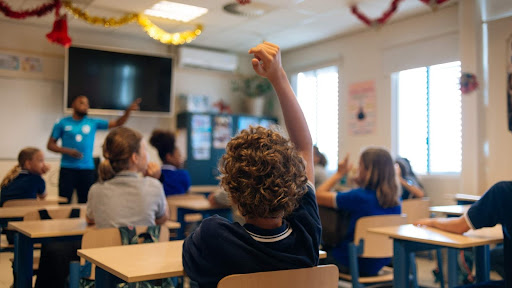How to Set Up Classwide Positive Behavioral Support: A Guide to Establishing Proactive Management
Components of positive behavior support systems are part of all elementary school classrooms. Educators routinely use creative and effective ways to support student social and emotional behavior. Yet, enhancing current practice to make multiple approaches in concert can have wide-ranging positive effects.
With this guide, we will show you how to set up a classwide positive behavior support system that is sustainable for the long-term. You will also learn how establishing a proactive behavioral system can promote healthy social skills development for students and make the day-to-day more enjoyable for both teachers and students.
Table of Contents
- What Is Classwide Positive Behavioral Support?
- Understanding the ABCs of Behavior Presentation
- 5 Steps to Setting up a Classwide Positive Behavior Support System
- Illuminate Education: Providing Behavioral Intervention Resources and Support to Educators Across the U.S.
What Is Classwide Positive Behavioral Support?
Classwide positive behavioral support is a comprehensive school-based prevention and intervention program that reduces problem behavior and increases social skills.
A classwide positive behavioral support program is a research-backed and proactive approach to better:
- Student behavior
- Academic productivity and growth; and
- Development of social skills
This whole-class approach creates the systems and supports for all students to grow and develop.
Positive behavior support is a classroom management system with a focus on encouraging good behavior, rather than punishing or controlling students — incentivizing positive attitudes, increasing student motivation, and making learning more engaging.
Students need to know what classroom expectations are to meet them. Positive interventions, and classwide positive behavior support help students achieve that.
3 Benefits of Implementing Classwide Positive Behavior Support
A classwide positive behavior support plan is a whole-class, proactive, preventive, and systematic approach to managing student classroom behavior.
All students can learn appropriate behaviors so teaching what is appropriate can prevent misbehavior.
Let’s look at three big benefits of implementing classwide positive behavior.
#1: Students Know What to Expect
Students need to understand what you expect of them in each situation. In order for that to happen, there should be clear classroom rules that are reinforced with regularity, routines that are predictable, and structure that ensures students are set up to succeed.
To ensure that classroom rules and expectations are clear, students should get the opportunity to:
-
-
- Ask questions
- Practice certain skills; and
- Get feedback in a positive manner
-
School teachers and staff members need to demonstrate consistency in their encouragement of these behaviors for students to rise to the expectations.
#2: Intervention Can Help Prevent More Serious Behavior Problems
Intervention for classwide positive behavior support is the first of a series of steps that help students with misbehavior.
The Tier 1 intervention plan can be a cost-effective way to help schools reach their goals. They can be implemented quickly and easily, which is an advantage for schools with limited resources.
However, Tier 2 intervention support is most effective with classwide positive behavior systems.
Interventions can help prevent serious individual Tier 3 behavior problems from occurring in the future and improve the school climate.
#3: Support Strategies Are Data-Driven
Classwide positive behavior support strategies should be data-driven and based on science and research.
By using data-driven support, educators expect to see:
-
-
- Reduced discipline referrals; and
- Improved academic performance
-
These proven strategies are effective in schools across the country. With the data, schools can decide on the best behavior interventions for students.
Understanding the ABCs of Behavior Presentation
The ABCs of Behavior is a model that helps us understand how antecedents can influence behavior.
It has three parts:
- Antecedent (A)
- Behavior (B)
- Consequence (C)

A Is for Antecedent
Antecedents are the events that happen just before the behavior occurs — either positive or negative behavior.
The antecedents set up the behavior to occur and can include both external and internal “triggers” or stimuli that prompt a response from an individual and lead them to perform a certain behavior.
For example, if a student desires peer attention (antecedent), he or she may behave a certain way to prompt a response.
B Is for Behavior
In the classroom, behavior is what a student does, says, and thinks, and it is what teachers see and judge.
Another way to describe behavior in the classroom is a student’s way of interacting with his or her environment.
In the case of the student who wants peer attention (antecedent), he or she may make a smart remark to the teacher (behavior).
The consequences after the behavior either encourage or discourage behavior we want to see from our students.
C Is for Consequence
For our children to learn how to behave, we have to teach them what behaviors are appropriate in different contexts with consequences.
Therefore, teachers must be consistent in their approach so the children will know what they should do when they encounter various situations.
It’s important to note that ABCs are:
-
- A way for teachers to reward good behavior; and
- Based on working on positive reinforcement
- And as a result, not a punishment-based model
The consequence of classwide positive behavior support is to implement a “catch them being good” strategy that encourages the positive behavior that you want to see in your classroom in the future.
Going back to our previous example of the student who wants peer attention (antecedent):
He or she may make a smart remark to the teacher (behavior), and the consequence is that other students laugh (consequence).
However, the teacher can intercept this consequence with positive behavior by ignoring the negative student behavior and praising students who are staying on task.

5 Steps to Setting up a Classwide Positive Behavior Support System
The ABC system can apply to any type of classroom management strategy.
However, it works best with systems that are positive reinforcement-based.
Teachers should include direct instructions and student feedback to ensure a successful class-wide implementation of a positive behavior support system.
#1: Identify a Classwide Goal
Instead of focusing on individual and small group behavior supports, a classwide goal can be helpful to motivate the whole class.
Teachers should not address individual and small group goals classwide. Rather, they should identify a classwide goal and use it as the foundation for the whole-class behavioral intervention strategies.
#2: Clearly Define the Goal in Behavioral Terms
Behavioral terms are a way to measure whether you have achieved your goals.
The goal of your classwide positive behavior support should:
-
- Be easily understood and clearly defined in behavioral terms
- Be accessible to all students and staff
- Include the goal of the program
Classwide positive behavior supports should clearly define the behavior, such as “Attend to lesson,” which means looking at the teacher who is instructing, completing tasks related to the lesson, and working cooperatively with peers.
It should also inform the class about the behavior and provide the class positive examples of what the target behavior looks like, as well as counter-examples.
And lastly, classwide positive behavior supports should tell the class that they will be provided feedback throughout the lesson on how well they are doing.
#3: Promote Antecedent Control
The antecedent is the event that precedes a behavior.
Many schools create baseline expectations for students, including:
-
- “Be kind and respectful”
- “Make responsible decisions”; and
- “Get to class on time”
However, teachers usually need to set more specific expectations for their classwide behavior.
In the case of antecedent control for classwide positive behavior supports, the antecedents are strategically planned to have a positive effect on target students by clearly…
-
- Communicating
- Coaching; and
- Demonstrating
… to students how to behave and which behaviors are rewarded.
Students are more likely to comply when expectations are clearly defined and communicated.
#4: Promote Consequence Control
A key element of classwide positive behavior support is promoting consequence control for appropriate behaviors.
One well-known strategy for promoting consequence control is creating a behavior contract or class pledge that outlines:
-
- The expectations for each behavior; and
- The consequences of choosing misbehavior
When students know what the expectations are, they will likely have more positive behavior and fewer instances of misbehavior. A simple approach might be to tell the class “When you have completed your assignment, then you can talk quietly with a friend.”
Another strategy is to include three to five positive phrases and examples of appropriate behavior in the class pledge, such as:
-
- “The student will be able to stay on task and complete the assigned work when they are given specific instructions.”
- “The student will independently complete the assignment when they have access to appropriate materials.”
- “The student will independently complete the assignment when it is due by the end of class.”
The benefits of this approach are significant, and positive behavior support plans can lead to improved student performance and an overall more positive classroom environment.
#5: Clearly Explain the Procedures to the Class
For students to implement positive behavior support, teachers will need to clearly explain all classroom procedures.
The key to students meeting your expectations is to provide direct instructions for classroom procedures. Here’s how the instructions might go if you’re a teacher:
-
- Introduce and give the rationale behind the classroom expectations.
- Give clear scenarios of disrespectful and respectful classroom behaviors.
- Demonstrate positive behaviors, highlighting important aspects for students to remember.
- Have students role-play the positive behaviors and give them feedback and correction.
- Cue appropriate behavior inside and outside the classroom and prompt with positive reminders of the expectations.
Any of these steps may include students asking questions for clarity of expectations.
For constant behavior support in the classroom, it’s a good idea to establish lesson plans you can use to communicate expectations for each type of classroom procedure and routine.

Illuminate Education: Providing Behavioral Intervention Resources and Support to Educators
Our goal at Illuminate Education is to empower educators with the skills and resources they need to teach a well-rounded curriculum. We do this through the use of data and our expertise in classroom management and behavior intervention resources.
Illuminate Education’s Social-Emotional Behavior (SEB) Solution combines valid and reliable SEB assessments with MTSS collaboration and management tools to track things like attendance, incident referrals, intervention effectiveness, and early warning systems so you can make data-driven decisions about the whole child more effectively.
Ready to learn all about our SEB Solution can help your students. Let’s get in touch.
*****
Illuminate Education equips educators to take a data-driven approach to serving the whole child. By combining comprehensive assessment and MTSS management and collaboration tools, the Illuminate Solution enables educators to accurately assess learning, identify needs, align whole child supports, drive system-level improvements, and equitably accelerate growth for every learner.
Ready to discover your one-stop shop for your district’s educational needs? Let’s talk.


